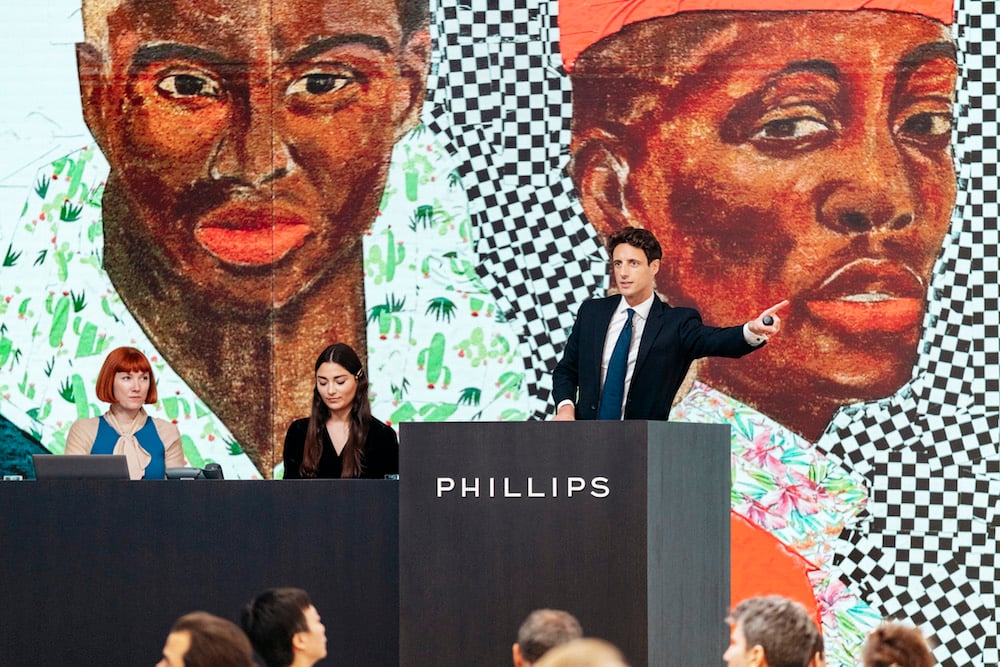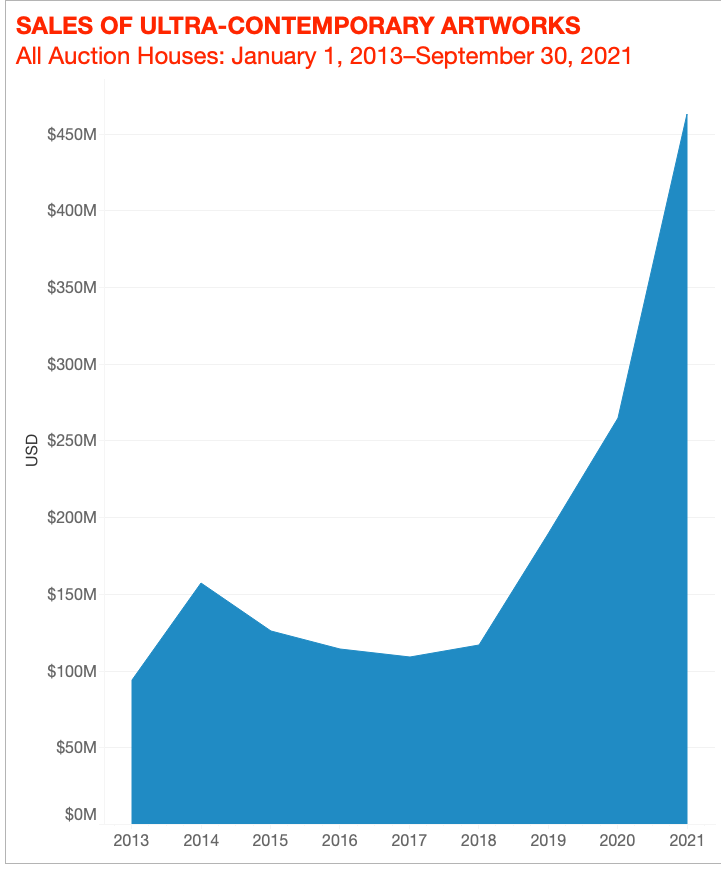Artnet News Pro
The Market for Ultra-Contemporary Art at Auction Has More Than Doubled Since 2019. What’s Driving the Boom?
We read the tea leaves in data from the Artnet Price Database to break down the trend.

We read the tea leaves in data from the Artnet Price Database to break down the trend.

Julia Halperin

At auction these days, the most heated contests are not for work by Mark Rothko, Jackson Pollock, or other habitués of Cedar Bar. Instead, they are for fresh paintings by artists who probably grew up watching Nickelodeon, collected Beanie Babies, and had a Tamagotchi.
Ultra-contemporary art—our term for work made by artists born after 1974—is the fastest-growing segment of the art market by far. And its momentum has only picked up during the pandemic. In the first nine months of 2021, $462.5 million worth of art from this category was sold at auction. That’s up 75 percent from the full year of 2020 and 145 percent from 2019.
Earlier this month, Sotheby’s announced it would launch a new marquee evening sale in New York called “The Now,” which is specifically dedicated to art made within the past few decades. It’s a sign of just how robust this market has become—and how quickly.
The chart below tells the story more concisely and clearly than I ever could.

© 2021 Artnet Price Database and Artnet Analytics.
It’s a lot to take in! So what is driving this yen for the new? Let’s take a closer look at the numbers.
We coined the term here at Artnet News back in 2019. (It hasn’t set the world on fire, but it has caught on a bit—Bloomberg used it once!) We realized that as the contemporary art market evolved, it required a bit more precision. What important trends were we obscuring if we lumped the likes of Andy Warhol, who died in 1987, and Avery Singer, who was born in 1987, into the same category? By creating a new moniker for artists born from 1975 to the present day, we sought to bring valuable visibility to the youngest talents with strengthening secondary markets. (We defined contemporary as artists born from 1945 to 1974.)
As anyone who has witnessed some of the recent bidding wars for works by artists such as Matthew Wong, Avery Singer, and Emily Mae Smith knows, this market is pretty much on fire. It was the genre least affected by the lockdown, falling only 1.3 percent in the first half of 2020. It also rebounded the most dramatically.
From January through June of this year, sales in the category ratcheted up to $302.6 million—almost 300 percent above their most recent peak in 2019. Remarkably, the size of the market for ultra-contemporary art is now rivaling that of Old Masters, which tallied $338.2 million worth of sales in the year’s first half. (For perspective: The former genre covers art made over the course of fewer than 50 years; the latter, more than six centuries.)
It’s true that supply is far more abundant—and growing—in this segment of the market than for, say, Old Masters. But it’s not just the volume of works at auction that’s spiking; the prices are, too. In 2013, the average price for a work of ultra-contemporary art at auction was $25,500. Fast forward to 2021 and that figure has doubled, to $51,415.
It can be attributed to a number of factors. First, millennial (and even Gen Z) collectors are a growing force in the market, and they are interested in collecting work by artists of their own generation, just as their parents were.
This new crop of collectors is also more motivated by profit than their predecessors. A recent report from Deloitte found that 64 percent of collectors under 35 cited investment returns among the most important factors in their art acquisitions, compared to 30 percent of collectors ages 35 and older.
Although many of these buyers have benefitted from the buoyancy of the stock and crypto markets over the past 18 months, they are likely not in a position to spend $40 million on a Rothko. Some of them would, however, rather spend $200,000 on a painting for the chance to flip it two years later for twice the price than to pay $20,000 for something they don’t think has any resale value.
Our previous reporting shows that Asian collectors have been extremely active in this segment. Record-breaking works by artists including Avery Singer, Joel Mesler, Jonathan Chapline, Genieve Figgis, Amoako Boafo, and Javier Calleja sold at this year’s spring Hong Kong auctions were all snapped up by Asian collectors aged 45 or younger.
The Artnet Price Database’s latest research backs this up. In 2020, Asia accounted for nearly half (47 percent) of ultra-contemporary art sales at auction, while the U.S. came in at just under 30 percent, and Europe followed with a 23 percent share.
So far this year, the U.S. has taken the lead in ultra-contemporary art sales—but that shift is likely due in large part to the $69 million auction of Beeple’s Everydays NFT, which was put together by Christie’s New York. Plus, in this age of online shopping, just because a work is sold through a particular office does not mean it is purchased by a local buyer. To wit: The winning bidder of the Beeple, the NFT production studio and crypto fund Metapurse, is based not in the U.S., but in Singapore.
In the first nine months of the year, the top performers in terms of total sales at auction are as follows:
These artists are at different stages in their careers—Schutz and Wood have resumes stacked with international museum exhibitions, for example, while Rokkaku has had comparatively little exposure outside Asia. Few art-world people had ever heard the name “Beeple” before March.
But all of the names on the above list—well, all of them except Beeple—have a few things in common. They are figurative painters who make work that is difficult for collectors to access on the primary market, which drives their prices up at auction. Also, they have individually generated more money at auction so far this year than Francis Bacon, Robert Motherwell, Hokusai, or Georgia O’Keeffe.